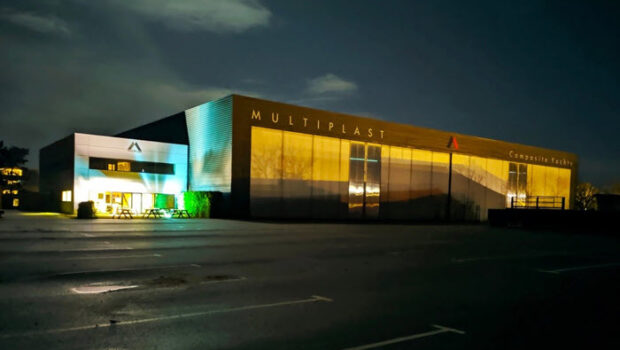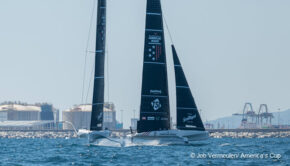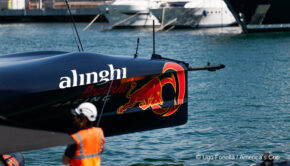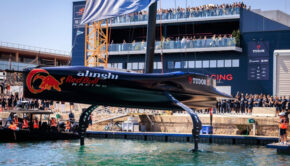Designed in New Zealand, Built in France
Published on March 25th, 2023
Boat builder Multiplast shares details regarding the French challenge for the 37th America’s Cup:
Multiplast have been chosen by the French Orient Express Team challenge to build the hull and deck of the French AC75. This new project in the America’s Cup is a real challenge for the Vannes yard, as explained by the general manager, Yann Penfornis, project manager, Samuel Napoleoni, and Antoine Carraz, the technical director for the challenge.
There is already a long and beautiful story linking Multiplast and the America’s Cup. Over the past 30 years, the yard has actually built six boats (five America’s Cup class and an AC50 flying catamaran) for French challenges involved in the oldest sporting trophy in the world.
As Yann Penfornis, Managing Director of Multiplast recalls: “We built F1 then Ville de Paris for Marc Pajot for the 1992 America’s Cup. Then there was 6e Sens for the 2000 edition in Auckland, the two Areva Challenge boats (2003) and the AC50 Groupama Team France for the 35th Cup in Bermuda in 2017.”
And so a new sequel is being written with the first approaches dating back to May 2022 by the founders of the French challenge, then called K-Challenge, Stéphane Kandler, and Bruno Dubois.
“A few weeks later, at the end of June, we had confirmation that we would work together to build the AC75 platform,” continues Yann Penfornis. “Unfortunately, the project was slowed because an investor pulled out. Everything accelerated again around November 15 when Stéphane Kandler and Bruno Dubois came back to us and the project restarted.”
On the part of the challenge, officially baptized Orient Express Team – from the name of the brand of the Accor group, title partner – a major advantage in this race against time has been the purchase of the design package of the future AC75 of Emirates Team New Zealand.
“The project would not have been viable without this agreement,” confides Antoine Carraz, who came from MerConcept to become the technical director of Orient Express Team. “Given the timing, the size of our team and the know-how of the New Zealanders, we will get a lot from the design they are providing for us. But we will have the freedom to adapt things if we wish.”
Yann Penfornis is delighted with this agreement which he considers historic: “It is the first time that a French team will be able to have the same level of maturity in the design of the platform as the defender. This is one hell of an opportunity!”
It is now down to those involved in the construction, who have to be French, according to the Protocol, to deliver the best possible boat, Multiplast in the first instance.
“Multiplast is going to build the hull, the deck, and the interior structure that holds it together and accepts all the forces through the platform,” explains Antoine Carraz. “The work will begin at the beginning of May with the manufacture of the hull and deck moulds, which will take about two months, until mid-July.
“We will then begin the layup of the hull, the deck and the various internal structures which will later be assembled in the hull, we will then close the box by grafting on deck. The build of this black box will end at the beginning of March 2024. The boat will then remain with Multiplast for the installation of systems and appendages. She will leave the yard at the end of April and will leave for Barcelona where she will be launched next May.”
The construction of this 75-foot foiling monohull, the first for the Cup since the last edition, promises to be technically more difficult than, for example, an IMOCA, and not only because it is bigger. This is highlighted by Samuel Napoleoni, head of the Cup project at Multiplast: “There are all the usual challenges of building racing boats (quality, planning, price, etc.), but with the inherent additional complexity, because it is the Cup.
“Necessarily in terms of the technical aspects, we are a cut above in terms of finesse of construction, details, sections to be laid up. We also use more high-tech materials, such as honeycomb aluminum (instead of Nomex honeycomb) which is more complicated to use.”
And of course adding to the actual technical complexity is this particularly tight schedule, as Yann Penfornis points out: “You have to do around 45,000 hours of work in 10 months. By comparison, an IMOCA represents 30 to 35,000 hours over a period of 12 to 18 months. For the AC75, we therefore have to fit more hours into a shorter period of time.”
To meet these deadlines, Multiplast are mobilizing a third of its teams, i.e. around 30 full-time people, to which will be added reinforcements from the French challenge. “For the Cup, there is only one deadline. We just cannot afford to be late,” emphasizes Samuel Napoleoni.
Following the publication of the AC37 Protocol and AC75 Class Rule on November 17, 2021, the AC75 Class Rule and AC Technical Regulations were finalized on March 17, 2022. The entry period opened December 1, 2021 and runs until July 31, 2022, but late entries for the 37th America’s Cup may be accepted until May 31, 2023. The Defender was to announce the Match Venue on September 17, 2021 but postponed the venue reveal, confirming it would be Barcelona on March 30, 2022. The 37th America’s Cup will be held in September/October 2024.
Teams revealed to challenge defender Emirates Team New Zealand (NZL):
• INEOS Britannia (GBR)
• Alinghi Red Bull Racing (SUI)
• Luna Rossa Prada Pirelli Team (ITA)
• NYYC American Magic (USA)
• K-Challenge Racing (FRA)
Noticeboard: https://ac37noticeboard.acofficials.org/
Additional details: www.americascup.com/en/home









 We’ll keep your information safe.
We’ll keep your information safe.